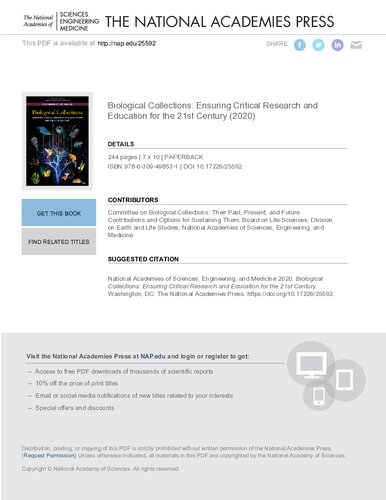

Most ebook files are in PDF format, so you can easily read them using various software such as Foxit Reader or directly on the Google Chrome browser.
Some ebook files are released by publishers in other formats such as .awz, .mobi, .epub, .fb2, etc. You may need to install specific software to read these formats on mobile/PC, such as Calibre.
Please read the tutorial at this link: https://ebookbell.com/faq
We offer FREE conversion to the popular formats you request; however, this may take some time. Therefore, right after payment, please email us, and we will try to provide the service as quickly as possible.
For some exceptional file formats or broken links (if any), please refrain from opening any disputes. Instead, email us first, and we will try to assist within a maximum of 6 hours.
EbookBell Team

5.0
78 reviewsBiological collections are a critical part of the nation's science and innovation infrastructure and a fundamental resource for understanding the natural world. Biological collections underpin basic science discoveries as well as deepen our understanding of many challenges such as global change, biodiversity loss, sustainable food production, ecosystem conservation, and improving human health and security. They are important resources for education, both in formal training for the science and technology workforce, and in informal learning through schools, citizen science programs, and adult learning. However, the sustainability of biological collections is under threat. Without enhanced strategic leadership and investments in their infrastructure and growth many biological collections could be lost.
Biological Collections: Ensuring Critical Research and Education for the 21st Century recommends approaches for biological collections to develop long-term financial sustainability, advance digitization, recruit and support a diverse workforce, and upgrade and maintain a robust physical infrastructure in order to continue serving science and society. The aim of the report is to stimulate a national discussion regarding the goals and strategies needed to ensure that U.S. biological collections not only thrive but continue to grow throughout the 21st century and beyond.
Table of Contents